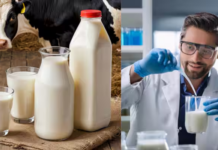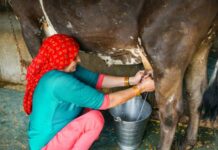New Delhi, October 26, 2023 : Cheesemakers are constantly striving to make high-quality cheese by avoiding the occurrence of any unwanted attributes or defects. There are many causes of defects in cheese and I will focus on those that are directly related to microbiological issues. We can broadly separate the source of this contamination into those occurring on the farm or at the cheese plant.
Let’s start at the beginning: on the farm. The farm environment is rich reservoir, or source, of microbial contaminants; some are harmless or even beneficial for aged cheese flavor development and some contaminants negatively impact cheese quality while others are pathogens. Sources include the soil, feed (e.g., grass, silage), bedding, water, buildings, milking equipment, personnel, and from the animals themselves. Manure from cows can contain high levels of pathogens like E. coli, Listeria, Salmonella, and Clostridium.
Farmers have to be vigilant to ensure that all the teats/udder are washed, sanitized, and dried to avoid introducing bacteria into the milk. The milking equipment must be maintained in proper working order and the required cleaning/sanitation procedures must always be followed (i.e., times, temperatures, flow rates, pH, chemical concentrations, etc). Failure to achieve the correct temperature, chemical concentration, or washing time can result in the incomplete removal of all milk residues, which allows biofilms to form.
A biofilm is a thin layer of microorganisms (and other milk components like proteins and salt may also be present) that adhere to a surface of a pipe, tank, or any other part of the milking equipment. As a biofilm matures, it begins sloughing bacteria, like Lactobacilli, which can then contaminate milk. Biofilms are hard to remove (often requiring specific procedures/chemicals or manual cleaning) and they can continuously contaminate the fresh raw milk.
It should be noted that raw milk quality has greatly improved over the past 100 years with standard plate counts of 5,000 cfu/ml for raw milk common for many Wisconsin dairy farmers. In contrast, however, back in 1910 we have seen reports of raw milk containing over 100 million cfu/ml (part of the reason for this high number was the lack of adequate cooling which allowed bacteria to grow during storage). Rapid cooling of raw milk and the maintenance of low temperatures are key factors in restricting bacterial growth.
Now, let’s move on to the cheese plant. The first key step is the pasteurizer. If the pasteurizer is not cleaned properly or has biofilms, it is a major problem. Biofilms are more often seen in plants where the pasteurizer is essentially running for long periods of time without a wash. Typically, biofilms form in the pasteurized side of the regeneration section of the pasteurizer, where temperatures (e.g., 45-60 degrees Celsius) are favorable for the growth of thermophilic bacteria.
If pasteurization is done properly and there are no biofilms, the amount of heterofermentative bacteria like Lactobacilli (derived from high quality raw milk) should be less than 1 cfu/mg after pasteurization. We often check for levels of heterofermentative bacteria to indicate if a biofilm is likely present. Heterofermentative bacteria can ferment residual lactose or galactose in cheese producing carbon dioxide, which can cause unwanted slits and cracks. They can also result in the production of off flavors.
Another factor that can cause microbial defects in cheese are improper storage and ripening conditions. Back around 1900, University of Wisconsin-Madison professors Stephen Babcock and Harry Russell conducted research on the “cold curing” of cheese. This research recommended shifting storage temperatures for cheese to close to refrigeration to prevent rapid and uncontrolled breakdown of the cheese. Cheesemakers adopted this new paradigm, which resulted in greatly improved cheese quality. In recent years, we are seeing more cheesemakers increase ripening temperature for some period to “accelerate” ripening, unfortunately faster ripening does not mean better quality. Higher temperatures (e.g., above 50 degree Fahrenheit) can result in cheese with unbalanced flavor and other defects like splits and cracks.
Here, at the Center for Dairy Research (CDR), staff are researching another source of cheese defects, the production of biogenic amines. This first came to our attention when we noticed Gouda cheese with gas defects like splits and cracks. However, we couldn’t find the typical galactose fermenting (heterofermentative) bacteria in the cheese. Upon further investigation, staff learned that some non-starter lactic acid bacteria have a very active decarboxylase enzyme, meaning they can produce amines from amino acids, releasing carbon dioxide or gas. In addition, some of these amines, which have names like cadaverine and putrescine, produce nasty off flavors. CDR staff are conducting research to figure out how to control these amines and avoid these defects.
It can be challenging to find the source or root cause of a cheese defect. One emerging technology that could really help the industry are genomic techniques that allow us to easily and accurately track the source of a microbial contaminate. This allows us to go back and sample various areas like the raw milk, pasteurizer, cheese vat, packaging device, etc., and test for those specific strains of bacteria.
Identifying the root causes of these defects is an important skill for our cheesemakers. That is why we have introduced critical thinking exercises in our Advanced Cheesemaking Short Courses at the CDR where cheesemakers are assigned a defect in a commercial cheese sample. The cheesemaker must then go through the likely manufacturing process and troubleshooting to identify the potential sources of contamination and suggest how best to remedy these issues. according to the reports published in www.dairyfoods.com .
From a microbiological perspective, cheese is a complex product. The bacteria and other components in cheese result in a range of flavors and notes but contaminants and unwanted bacteria can result in defects like off flavors or slits and cracks. Research and training can help avoid these unwanted defects in these complex products and allow our consumers to fully enjoy the diverse range of nutritious cheese varieties.


































